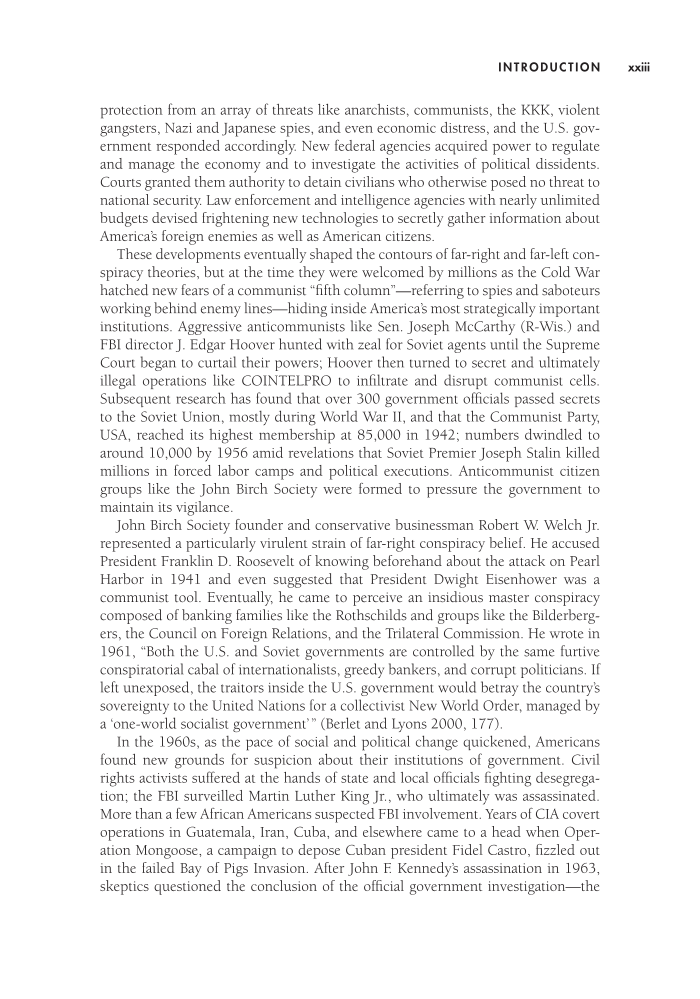Introduction xxiii protection from an array of threats like anarchists, communists, the KKK, violent gangsters, Nazi and Japanese spies, and even economic distress, and the U.S. gov- ernment responded accordingly. New federal agencies acquired power to regulate and manage the economy and to investigate the activities of political dissidents. Courts granted them authority to detain civilians who otherwise posed no threat to national security. Law enforcement and intelligence agencies with nearly unlimited budgets devised frightening new technologies to secretly gather information about America’s foreign enemies as well as American citizens. These developments eventually shaped the contours of far-right and far-left con- spiracy theories, but at the time they were welcomed by millions as the Cold War hatched new fears of a communist “fifth column”—referring to spies and saboteurs working behind enemy lines—hiding inside America’s most strategically important institutions. Aggressive anticommunists like Sen. Joseph McCarthy (R-Wis.) and FBI director J. Edgar Hoover hunted with zeal for Soviet agents until the Supreme Court began to curtail their powers Hoover then turned to secret and ultimately illegal operations like COINTELPRO to infiltrate and disrupt communist cells. Subsequent research has found that over 300 government officials passed secrets to the Soviet Union, mostly during World War II, and that the Communist Party, USA, reached its highest membership at 85,000 in 1942 numbers dwindled to around 10,000 by 1956 amid revelations that Soviet Premier Joseph Stalin killed millions in forced labor camps and political executions. Anticommunist citizen groups like the John Birch Society were formed to pressure the government to maintain its vigilance. John Birch Society founder and conservative businessman Robert W. Welch Jr. represented a particularly virulent strain of far-right conspiracy belief. He accused President Franklin D. Roosevelt of knowing beforehand about the attack on Pearl Harbor in 1941 and even suggested that President Dwight Eisenhower was a communist tool. Eventually, he came to perceive an insidious master conspiracy composed of banking families like the Rothschilds and groups like the Bilderberg- ers, the Council on Foreign Relations, and the Trilateral Commission. He wrote in 1961, “Both the U.S. and Soviet governments are controlled by the same furtive conspiratorial cabal of internationalists, greedy bankers, and corrupt politicians. If left unexposed, the traitors inside the U.S. government would betray the country’s sovereignty to the United Nations for a collectivist New World Order, managed by a ‘one-world socialist government’ ” (Berlet and Lyons 2000, 177). In the 1960s, as the pace of social and political change quickened, Americans found new grounds for suspicion about their institutions of government. Civil rights activists suffered at the hands of state and local officials fighting desegrega- tion the FBI surveilled Martin Luther King Jr., who ultimately was assassinated. More than a few African Americans suspected FBI involvement. Years of CIA covert operations in Guatemala, Iran, Cuba, and elsewhere came to a head when Oper- ation Mongoose, a campaign to depose Cuban president Fidel Castro, fizzled out in the failed Bay of Pigs Invasion. After John F. Kennedy’s assassination in 1963, skeptics questioned the conclusion of the official government investigation—the
Document Details My Account Print multiple pages
Print
You have printed 0 times in the last 24 hours.
Your print count will reset on at .
You may print 0 more time(s) before then.
You may print a maximum of 0 pages at a time.





































































































































































































































































































































































































































































































































































































































































































































































































































































































